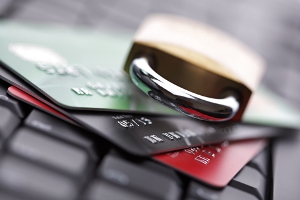Protect your Cards from Multiple Kinds of Skimmers
PIN may sometimes stand for pilfered identification number if a hacker gets yours. And it’s easier than ever for thieves to get your PIN from an ATM, coming up with clever ways to beat security technology.
 The “primitive” way to get your card number is to manually place a phony card reader over an ATM card reader and then come back to retrieve it. Now it’s being done wirelessly via Bluetooth and SMS tech built into the skimmer. Coupled with wireless cameras and keypad overlays, getting your PIN is easier than ever.
The “primitive” way to get your card number is to manually place a phony card reader over an ATM card reader and then come back to retrieve it. Now it’s being done wirelessly via Bluetooth and SMS tech built into the skimmer. Coupled with wireless cameras and keypad overlays, getting your PIN is easier than ever.
They’re also brazen enough to land jobs that will grant them ATM access; they then install malware that can transmit your PIN to their personal device. PIN hacking’s memory chips and transmitters are thinner and lighter these days, making them go undetected.
The crime of ATM skimming racks up $350,000 a day.
- Wedge skimming. An employee runs a card through a card reader tool that transfers data from the card’s stripe. The crook downloads this to his device, then burns the data onto a phony card or uses the data to place online or phone orders.
- Fake ATMs. The crook installs the phony machine in a place that will attract users like a saucer of honey will attract bees. The machine will read and copy tons of data.
- ATM skimming. The thief fits a card reader onto an ATM or gas pump card reader. The very inconspicuous reader may have wireless technology. This crime often comes with installation of secret pinhole cameras nearby to capture the consumer’s PIN.
- Data intercepting. A thief poses as a gas pump serviceman and unlocks it with special keys, then plants a device inside that reads all the customer cards’ unencrypted information.
- Point of sale swapping. The skimming device is placed at the terminal where you make a purchase. Even busy places like McDonald’s have been targeted.
These smart criminals can copy skimmed credit card data on gift cards, blank cards, hotel cardkeys or white cards, the latter being quite useful at self-checkouts. Protection comes in the form of:
- Anti-Skim Security built into the ATM from the factory or as an add-on solution, which is installed inside the machine
- Checking your statements every day via a smartphone app or every week online or monthly via your paper statement for suspicious transactions
- Challenging questionable transactions right away
- When entering your PIN, conceal the keypad with your other hand
- After handing an employee your card, keeping a close eye on it. Don’t let the employee leave your site with your card.
A crook (often a store employee in this case) can also nab your data with a handheld skimming device like the “wedge” listed above.
The Many Faces of Skimming
- Remember, the phony skimming device that’s attached to the card reader goes undetected by the consumer, unless the consumer is well-versed in this kind of crime and knows what to look for.
- The crooked employee gets your information, then sells it.
- Thieves can now get the data via wireless technology like Bluetooth, eliminating the risk of getting caught at the machine.
- Pinhole cameras can be placed anywhere close by, such as in a brochure holder.
- A crook may place a data capturing device over the keyboard to get PINs.
Get familiar with the ATM you use—because you should be using the same one so that it will be easier to spot something different about it.
Robert Siciliano is an Identity Theft Expert to Hotspot Shield VPN. He is the author of 99 Things You Wish You Knew Before Your Identity Was Stolen See him discussing internet and wireless security on Good Morning America. Disclosures.


























